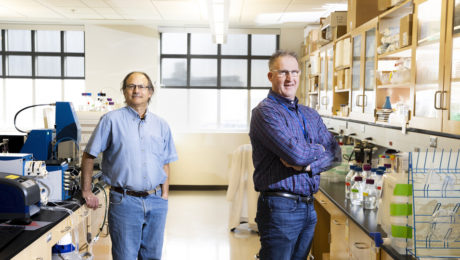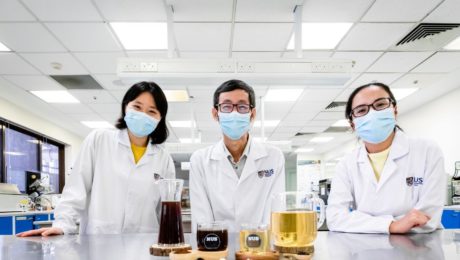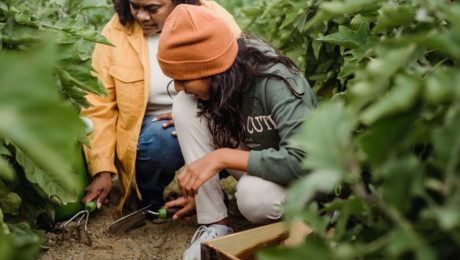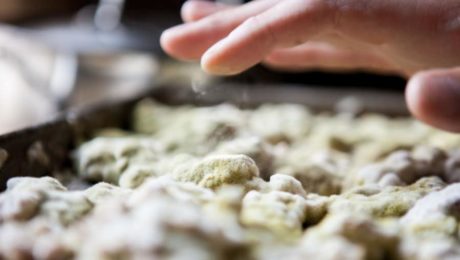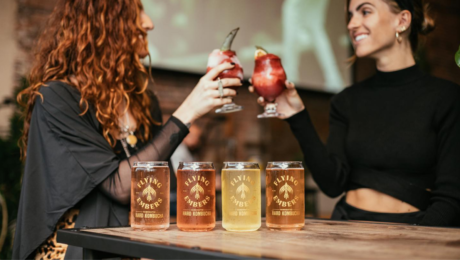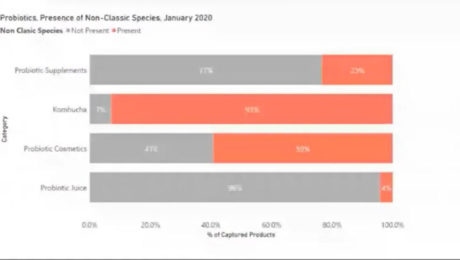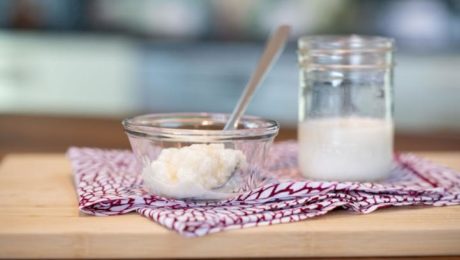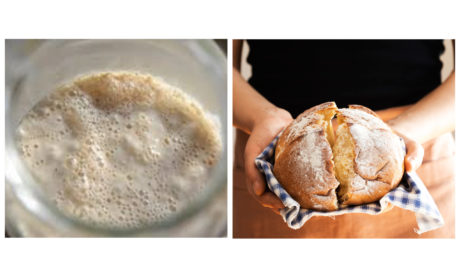Deciphering Real Fermented Products?
Consumers wanting fermented products must be careful shoppers, cautions Bob Hutkins, Khem Shahani Distinguished Professor of Food Science at the University of Nebraska-Lincoln. [Hutkins, at left in photo, will be speaking at the March 16 TFA webinar on The New Definition of Fermented Food.]
Many products considered fermented (and even labeled fermented) actually contain no live microbes. Sauerkraut stored in a can at room temperature, for example, was heat treated, so the live microbes were killed. He advises to look for products that say “not pasteurized” or “not heat treated.”
So what role do fermented foods play in our gut microbiome? Hutkins says: “The microbes transform proteins into amino acids and sugars into organic acids and they produce vitamins directly in the food. We benefit from that. For example, certain yogurts are more digestible and contain more vitamins than the milk from which they were made. Once we consume those products, the microbes have a chance to reach the gut. Now, we know they do not take up permanent residence, but they could live there for a short period of time and in doing so, they can outcompete pathogens, displace unwanted organisms, and again, produce vitamins and other bioactive molecules directly in the gut.”
Hutkins and Andy Benson, Professor of Food Science at the University of Nebraska-Lincoln, launched Synbiotic Health last year. The company brings their research into the gut microbiome to the marketplace.
Read more (Nebraska Today)
New Fermented Coffee & Tea Drinks
Researchers from the National University of Singapore (NUS) have created new fermented coffee and tea drinks. These drinks, invented by a professor and two doctoral students, are being labeled as “probiotic coffee and tea drinks that are packed with gut-friendly live probiotics.” They claim that the drinks can be stored for three months without altering the probiotics.
“Coffee and tea are two of the most popular drinks around the world, and are both plant-based infusions. As such, they act as a perfect vehicle for carrying and delivering probiotics to consumers. Most commercially available probiotic coffee and tea drinks are unfermented. Our team has created a new range of these beverages using the fermentation process as it produces healthy compounds that improve nutrient digestibility while retaining the health benefits associated with coffee and tea,” explained NUS Associate Professor Liu Shao Quan.
Read more (Science Daily)
Does Geography Matter for Sourdough Flavor?
Results of the first large-scale study of sourdough starters were released last week — and the conclusions are fascinating, challenging myths about sourdough. Scientists from four different universities studied 500 sourdough starters from four continents, with an aim to determine microbial diversity.
“We didn’t just look at which microbes were growing in each starter,” says Erin McKenney, co-author of the paper and an assistant professor of applied ecology at North Carolina State University. “We looked at what those microbes are doing, and how those microbes coexist with each other.”
The most striking finding: geography doesn’t matter.
Sourdough enthusiasts preach that location and climate will alter sourdough flavor. San Francisco has long held bragging rights for the most distinctive taste profile. But, of the 500 samples, there was little evidence of geographic patterns.
“This is the first map of what the microbial diversity of sourdoughs looks like at this scale, spanning multiple continents,” says Elizabeth Landis, co-lead author of the study and a PhD student at Tufts. “And we found that where the baker lives was not an important factor in the microbiology of sourdough starters.”
Alex Corsini, CEO and founder of sourdough pizza brand Alex’s Awesome Sourdough (and TFA advisory board member), says the research “demystifies the misconception that sourdough is only good in certain pockets of the world such as San Francisco.” Great sourdough, he says, is about the raw materials.
“It further shows why sourdough is ubiquitous all over the world — starters can thrive anywhere as nature provides the magic and bakers just need to be in a position to coax out a result without ruining the magic — the magic here being the microbial balance needed to ferment and levain baked goods,” Corsini says.
The research also found there is no one single variable responsible for sourdough variations, bucking conventional baking wisdom.
“What we found instead was that lots of variables had small effects that, when added together, could make a big difference,” says Angela Oliverio, co-lead author of the study and a former PhD student at the University of Colorado, Boulder. “We’re talking about things like how old the sourdough starter is, how often it’s fed, where people store it in their homes, and so on.”
As a commercial sourdough producer, Corsini values the “low and slow” process to master a sourdough batch, especially when making it consistently on a large scale. Alex’s Awesome Sourdough undergoes a 70-hour ferment using high-quality flour, filtered water and a decades-old starter.
“Although location makes little or no impact on the starters microbial ecosystem, regulating temperature and time is fundamental and adjustments need to be made based on the location you are in (hot climate, cold climate, humidity, etc.) to get a desired result,” Corsini says. “We make slight adjustments throughout the year to ensure a consistent texture and flavor in our dough.”
The study found variations in dough rise rates and aromas were due to acetic acid bacteria, “a mostly overlooked group of sourdough microbes.” The bacteria slowed the rise time and gave the sourdough a vinegary smell. Researchers were “surprised” that 29.4% of the samples contained acetic acid bacteria.
“The sourdough research literature has focused almost exclusively on yeast and lactic acid bacteria,” says Ben Wolfe, co-author of the study, associate professor of biology at Tufts University (and also a TFA advisory board member). “Even the most recent research in the field hadn’t mentioned acetic acid bacteria at all. We thought they might be there to some extent, since bakers often talk about acetic acid, but we were not expecting anything like the numbers we found.”
The 500 sourdough starters studied mostly came from home bakers in the U.S. and Europe. Researchers performed DNA sequencing for each sample, narrowing down to 40 starters as being representative of the diversity of the original array.
Those 40 were: assessed by sensory professionals for aroma profile, chemically analyzed to determine the organic compounds released by each and then measured for dough rise time.
“I think it’s also important to stress that this study is observational — so it can allow us to identify relationships, but doesn’t necessarily prove that specific microbes are responsible for creating specific characteristics,” says Wolfe. “A lot of follow-up work needs to be done to figure out, experimentally, the role that each of these microbial species and environmental variables plays in shaping sourdough characteristics.”
“And while bakers will find this interesting, we think the work is also of interest to microbiologists,” Landis adds. “Sourdough is an excellent model system for studying the interactions between microbes that shape the overall structure of the microbiome. By studying interactions between microbes in the sourdough microbiome that lead to cooperation and competition, we can better understand the interactions that occur between microbes more generally — and in more complex ecosystems.”
The research, “The Diversity and Function of Sourdough Starter Microbiomes,” was done with support from a National Science Foundation grant.
- Published in Food & Flavor, Science
Fermented Food Waste Increases Crop Growth
Scientists have found a sustainable solution for dealing with both food waste and soil health. They’ve discovered fermented food waste boosts bacteria that increases crop growth, makes plants more resistant to pathogens and reduces carbon emissions from farming.
“Beneficial microbes increased dramatically when we added fermented food waste to plant growing systems,” said Deborah Pagliaccia, the microbiologist who led the research at University of California Riverside (UCR). “When there are enough of these good bacteria, they produce antimicrobial compounds and metabolites that help plants grow better and faster.”
The UCR research team used two types of fermented byproducts: beer mash (byproduct of beer production) and food waste discarded by grocery stores; neither tested positive for salmonella or any other pathogenic bacteria.
Read more (Science Daily)
- Published in Science
New Fermented Alternative Proteins
“2020 was a banner year for fermentation,” says Emma Ignaszewski at the Good Food Institute (GFI). “Fermentation is poised to solve so many challenges in the alternative protein space,” she adds. It’s scalable, low-cost and “it can produce proteins that match the taste, texture, and nutritional qualities of animal-based proteins. In some sense, it’s quite possibly the dark horse of the protein world.”
Biotech companies are using yeast engineering and fermentation technologies to cultivate new strains. GFI invested a record $435 million in fermented protein in 2020. Clara Foods makes egg white protein using fermentation. Nature’s Fynd makes a fermented protein “Fy” made from fungi in an acidic Yellowstone hot spring. Perfect Day makes plant-based, lactose-free proteins for ice cream using fermentation. Prime Roots uses koji as a protein alternative.
Ignaszewski says that meat is a category “ripe for disruption” by fermented protein.
Read more (LiveKindly)
Pandemic Spurs Fermented Beverages
The coronavirus continues to drive sales of fermented drinks. Lifeway’s kefir, Farmhouse Culture’s kraut juice, Probitat’s fermented planted-based smoothies, Flying Ember’s hard kombucha and Buoy Hydration’s fermented drinks all report increased sales as consumers take a bigger interest in the immune-enhancing benefits of fermented beverages.
“As demand ramps up for immune-enhancing products, manufacturers have an opportunity to innovate with immune-supporting ingredients and flavors,” says Becca Henrickson, marketing managed of Wixon, a flavor and seasoning company. “When flavoring beverages with immune support ingredients, selecting flavors that increase or complement a product’s health perception is optimal.”
Read more (Food Business News)
New Strains Drive Probiotic Market
Kombucha and cosmetics are driving growth in the probiotic and prebiotic markets by making products that use non-classic strains of bacteria.
The e-commerce market for probiotic supplements was estimated at $973 million across 20 countries in 2020. America accounts for almost half of those sales. Ewa Hudson, director of insights for Lumina Intelligence, shared this info at the Probiota Americas 2020 Conference. (Lumina and Probiota Americas are parts of William Reed Business Media, the parent company for FoodNavigator.com.) The session, New Horizons for Prebiotics & Probiotics, included Lumina’s insight into non-classic bacteria strains and a panel discussion with leaders in the probiotics field.
In 2020, 32% of all probiotics in America — and 41% of the best-selling ones — contained non-classic species. Hudson said this species classification is a messy space, especially from a consumer’s perspective, because there are so many species. Kombucha includes the most non-classic probiotic species — of those products with probiotics, 93% include non-classic bacteria .
Most products with probiotics include one of the four common bacteria species: lactobacilli, bifidobacterium, bacillus and saccharomyces. Lumina excluded these four from their research to focus on the growth of the non-classic probiotic strains. These include: streptococcus thermophilus, kombucha culture, lactococcus lactis, bifida ferment lysate, enterococcus faecium, streptococcus salivarius, clostridium butyricum and streptococcus faecalis.
Though probiotics are often used in supplements, more fermented food and beverage manufacturers are using probiotic strains in their products, especially in the growing alternative protein market.
Synbiotics are also becoming more widely used; the study found synbiotics were the most prevalent formulate in probiotics. Synbiotics are a combination of both prebiotics and postbiotics. A synbiotic ensures that probiotics will have a food source in the gut.
(Probiotics are live microorganisms, friendly bacteria that provide health benefits. Probiotics can be found in fermented food and taken as supplements. Prebiotics are dietary fibers that feed the probiotics. Postbiotics are an emerging concept in the “biotics” space — postbiotics are the waste byproduct of probiotics.)
“With probiotics, we are really only starting to scratch the surface with the development of synbiotics,” says Jens Walter, PhD, professor of ecology, food and the microbiome at APC Microbiome Ireland.
The new generation of probiotics will depend on strains that are “efficacious in the gut,” Walter noted.
“If you look into the probiotic market, most of the lactobacillus species — and also species like bifidobacterium lactis — are not inherent organisms of the human gut. We’re using a lot of organisms that I would argue have an ecological disadvantage in the gut,” Walter says. “If you’re talking about next generation probiotics, I think what will become is we are looking for the key players in the gut, specifically key players that are underrepresented or linked to certain benefits, and then we are trying to put them back in the ecosystem.”
It’s challenging to find a prebiotic or postbiotic that is precise, he continues.
“Every human has a distinct microbiome. So it’s likely a synbiotic designed for one human may not be as functional in another human,” Walter says. “The opportunities here are tremendous.”
Daniel Ramon Vidal, vice president of research and development and health and wellness at the American food processing company Archer-Daniels-Midland (ADM), also spoke. He noted that the human body is made up of trillions of microbial cells, but we know little about these microbial worlds.
“There is an enormous amount of possibilities to isolate new strains that are living in our body,” Daniels says. “We need as much science as possible, that’s my message”
The panel agreed that postbiotics has become one of the next great concepts that scientists, manufacturers and gastroenterologists have latched onto. But consumers are not as familiar with postbiotics as they are with probiotics and prebiotics , notes Justin Green, PhD, director of scientific affairs for EpiCor, a postbiotic ingredient produced by Cargill.
“This causes more confusion, so I think that’s going to be another interesting aspect of postbiotics — both the identity of what postbiotics are and how it confers its benefits and (how that will be) communicated to the consumer,” Green says.
New Global Definition for Fermented Foods
A major scientific announcement was made this week, creating a global definition for fermented foods. A team of 13 interdisciplinary scientists (including TFA Advisory Board members Maria Marco and Ben Wolfe) spent over a year discussing the issue in order to reach a consensus. An official definition has long been debated, especially in recent years as fermentation has experienced a renaissance in the modern diet. This definition, the first of its kind, hopes to provide clarity to scientists, producers and consumers.
Below is a press release from the International Scientific Association for Probiotics and Prebiotics (ISAPP) on the definition. The full research paper was published in Nature. Marco also wrote a blog on the ISAPP website, further detailing the work that led to the definition.
Humans have consumed different types of fermented foods — from kimchi to yogurt — for thousands of years. Yet only recently, with the availability of new scientific techniques for analyzing their nutritional properties and microbiological composition, have scientists begun to understand exactly how the unique flavors and textures are created and how these foods benefit human health.
Now, 13 interdisciplinary scientists from the fields of microbiology, food science and technology, family medicine, ecology, immunology, and microbial genetics have come together to create the first international consensus definition of fermented foods. Their paper, published in Nature Reviews Gastroenterology & Hepatology, defines fermented foods as: “foods made through desired microbial growth and enzymatic conversions of food components”.
The authors take care to note the difference between probiotics and the live microbes associated with fermented foods. The word ‘probiotic’, they say, only applies in special cases where the fermented food retains live microorganisms at the time of consumption, and only when the microorganisms are defined and shown to provide a health benefit, as demonstrated in a scientific study.
“Many people think fermented foods are good for health — and that may be true, but the scientific studies required to prove it are limited and have mainly focused on certain fermented food types,” says first author Maria Marco, Professor in the Department of Food Science and Technology at the University of California, Davis.
Co-author Bob Hutkins, Professor in the Department of Food Science and Technology at University of Nebraska, Lincoln — who has authored a well-known academic textbook on fermented foods — says, “We created this definition to cover the thousands of different types of fermented foods from all over the world, as a starting point for further investigations into how these foods and their associated microbes affect human health.”
The consensus panel discussion was organized in 2019 by the International Scientific Association for Probiotics and Prebiotics (ISAPP), a non-profit organization responsible for the published scientific consensus definitions of both probiotics (in 2014) and prebiotics (in 2017).
Mary Ellen Sanders, Executive Science Officer of ISAPP, says, “To date, different people have had different ideas of what constitutes a fermented food. The new definition provides a clear concept that can be understood by the general public, industry members and regulators.”
Currently, evidence for the positive health effects of fermented foods has relied more on epidemiological and population-based studies and less on randomized controlled trials. The authors expect that, in the years ahead, scientists will undertake more hypothesis-driven research on how different fermented foods from around the globe — derived from dairy products, fruit, vegetables, grains, and even meats — affect human physiology and enhance human health.
Global Fermentation: Today & Tomorrow
The health attributes and unique flavors of fermented food and drink are becoming increasingly more important to consumers. But, for fermentation brands to succeed in the food industry, they must prioritize their labeling and marketing, and focus on their environmental impact, says international food industry expert Lisa Moeller.
“Hopefully, it will be as advantageous to attach ‘Fermented’ as it is ‘Fresh Pack’ to shelf stable pickle products at some point in time,” says Moeller, speaking at a recent TFA webinar: Global Fermentation: Today & Tomorrow. “Never in our history has the power of positive change been more possible and necessary. I think there is an inherent history with fermented vegetables and a trajectory that can only take them higher going forward.”
After receiving her master’s degree in food science, Moeller spent 25 years working with Mount Olive Pickle Company in North Carolina. She later started her own company, Fashionably Pickled, where she consults to food brands on methods – such as assisting with traditional fermentation technology – for crafting better products.
Fred Breidt, microbiologist with USDA-ARS and a TFA advisory board member, called Moeller “one of the premiere pickle people in the United States,” and praised her for working around the world on a variety of fermentations.
Moeller shared three forecasts for fermented foods.
- Health Concerns Become More Important
Consumers are more concerned about their health during the COVID-19 pandemic. “Folks are looking to boost immunity, reduce their weight and they’re looking for nutritious options,” Moeller says.
People are also cooking more at home during the pandemic. Restaurant dining had continually increased over the previous two decades and, in recent years, only half the food eaten in the U.S. was purchased from a grocery store. But when COVID-19 hit, “this 23 year trend was blown out of the water,” says Moeller. By April 2020, 65% of the food consumed came from a grocery store, with less than 35% from restaurants.
“I think this trend gives the fermented vegetable arena great potential,” Moeller says. “Fermented vegetables can increase the shelf life of produce, they’re nutritious, and they can be turned into a wide variety of flavors. And I think for a time, people are going to be more interested in having a supply of things in their pantry when they don’t feel comfortable going to a grocery store.”
Increased research will help promote fermentation as a viable health food. There are still consumers who are off-put by fermentation, leaving room for brands to educate.
“Though a large part of the pickle industry is still involved with fermented cucumbers, it is not the leader in the retail category at this time,” Moeller says. “We don’t label ‘fermented’ in America. Lots of times with the cucumber industry, the fermented kind of becomes the offshoot. It’s kind of the have-to-do so you can produce all the fresh pack that you want and still have a home for others.”
- Labelling and Marketing Are Crucial
Food product labels and marketing must adapt to their local markets. Brands must create different labelling, packaging and marketing plans, depending on the country.
“There truly is no such thing as global tastebuds. But there are successful product adaptations,” Moeller says.
Consider Kentucky Fried Chicken (KFC) as an example. There are over 23,000 KFC locations in 140 countries, and the restaurants adapt to regional flavor preferences, selling different styles of food depending on the location. Coca-Cola is another example. With 500 brands in 200 countries, a can of Coke will taste different depending on the country where it was sold.
“Labelling is even more important when selling your brand. Know what is important to the folks that are going to make the decision to add you products to their store shelves. Whole Foods is different than Walmart,” Moeller adds.
She advises to never make a label too complicated. Yogurt sales are projected to drop by 10% by 2024 “and this is partially because there are too many choices and the category has gotten too complicated.”
- Environmental Concerns Lead to Upcycllng
The environment is a big topic of concern worldwide, Moeller says.The global food system accounts for 26% of greenhouse gas emissions, 40% of the food produced is never consumed and 78% of global consumers are concerned about the environment.
Upcycling will be the new food trend. Brands like Toast Ale (beer made from old bread) and RISE + WIN Brewing Co. (who recycle grain scraps to make granola and sweets) are already making waves in the industry. During the pandemic, chefs reported using fermentation more than ever before to make use of uneaten produce.
“There’s not a vegetable out there that could be turned into something else,” Moeller says. “Turning food waste into alternative products…I think it’s one of the most wonderful ideas, (brands) need to partner with the folks that they want to get these byproducts from.”
- Published in Business, Food & Flavor
The Science Behind Sourdough
Sourdough has become the darling of the pandemic pantry, as people experiment with a starter of microbes in their home kitchen. Scientists are just beginning to “discover that the microbes in a sourdough depend not just on the native microbial flora of the baker’s house and hands, but also on other factors like the choice of flour, the temperature of the kitchen, and when and how often the starter is fed,” according to an article in Scientific American. The magazine interviewed multiple microbiologists on the science behind a great sourdough loaf.
“When we study sourdough science, we learn that we know remarkably little for a technology that’s — what? — 12,000 years old,” says Anne Madden, a microbiologist at North Carolina State University.
Read more (Scientific American)
- Published in Food & Flavor

